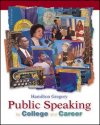|
 |  Public Speaking for College and Career, 6/e Hamilton Gregory
Feature Summary- Focusing on Audience - Audience-centered communication is emphasized throughout the book: how to analyze listeners; how to be sensitive to their needs and interests; and how to talk to and with them, not at them.
- Planning and Organizing - 11 chapters are devoted to showing students how to plan and organize a speech -analyzing the audience, selecting a topic and specific purpose, devising a central idea, finding verbal and visual support material, organizing the material into a coherent outline, and practicing effectively.
- Building Confidence A major concern for most beginning speakers is how they can develop and project confidence in themselves and in their ideas. Chapter 2 ("Controlling Nervousness") provides a reassuring discussion on nervousness, and shows students how to turn their speech anxiety into an asset by using it as constructive energy.
- Speaking in Real-World Situations -
Examples, stories, and photos throughout the book depict real people in real communication settings.
- "Tips for Your Career" appear in all chapters to give students useful advice for their professional development. "Special Techniques" give detailed explanations on such topics as "How to Use Humor."
- Developing Ethical Values - Ethical behavior and personal values are important matters for all communicators. Rather than restrict the discussion of ethics to an isolated chapter, ethical problems are discussed throughout the book at relevant points. These points are flagged by an "Ethical issues" icon in the margin of the text.
- Incorporating Technology - Students receive updated information on using multimedia and the Internet. Special emphasis is given to using PowerPoint electronic presentations, and several sample speeches are illustrated by PowerPoint slides. At the same time, students are warned about the pitfalls of using PowerPoint incorrectly.
- Conducting and Evaluating Research - Some librarians and instructors report that many students want to use the Internet--and nothing else--for research, but are unaware of how to use the Internet properly. To address this issue, "Building Internet Skills" exercises are located at the end of every chapter. Chapter 6 (Finding Information) shows students how to use the Internet effectively, but also describes the limitations of the Internet and warns students that they are making a mistake if they ignore traditional library resources.
- Building Critical Thinking Skills - To help students sharpen these skills, Chapter 7 (Using Information Wisely and Ethically) provides guidelines on how to separate credible from unreliable information, and how to develop a healthy skepticism. At the end of each chapter are "Building Critical Thinking Skills" exercises. Throughout the book, when each stage of preparation and delivery is discussed, students are encouraged to engage in critical analysis of their topic, audience, and material.
- Exploring Diversity and Teamwork - This book emphasizes understanding and valuing diversity. In addition to examples, tips and photos throughout the book, there are "Building Teamwork Skills" exercises at the end of each chapter. Chapter 1 confronts the problem of stereotyping and scapegoating. Chapter 4 has a detailed discussion of listeners from other countries and various ethnic groups, as well as tips regarding disabilities, gender, age, educational background, occupations, religious affiliation, and economic and social status. Chapter 19 provides guidelines on how individuals can work effectively in teams.
- Using Visual Imagery Over 130 graphics, including photos, drawings, tables, and sample presentation aids. Most of these visuals are new to this edition.
|
|
|



 2002 McGraw-Hill Higher Education
2002 McGraw-Hill Higher Education

 2002 McGraw-Hill Higher Education
2002 McGraw-Hill Higher Education